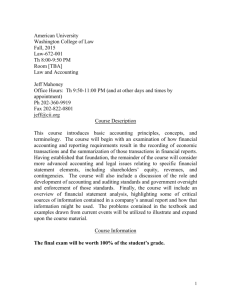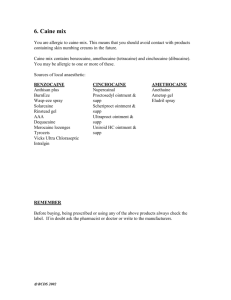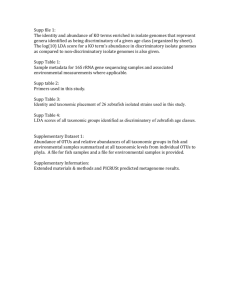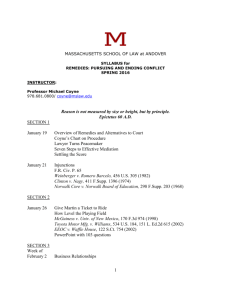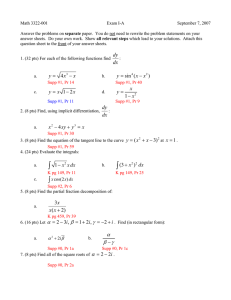STEADY VORTEX FLOWS OBTAINED FROM A CONSTRAINED VARIATIONAL PROBLEM
advertisement
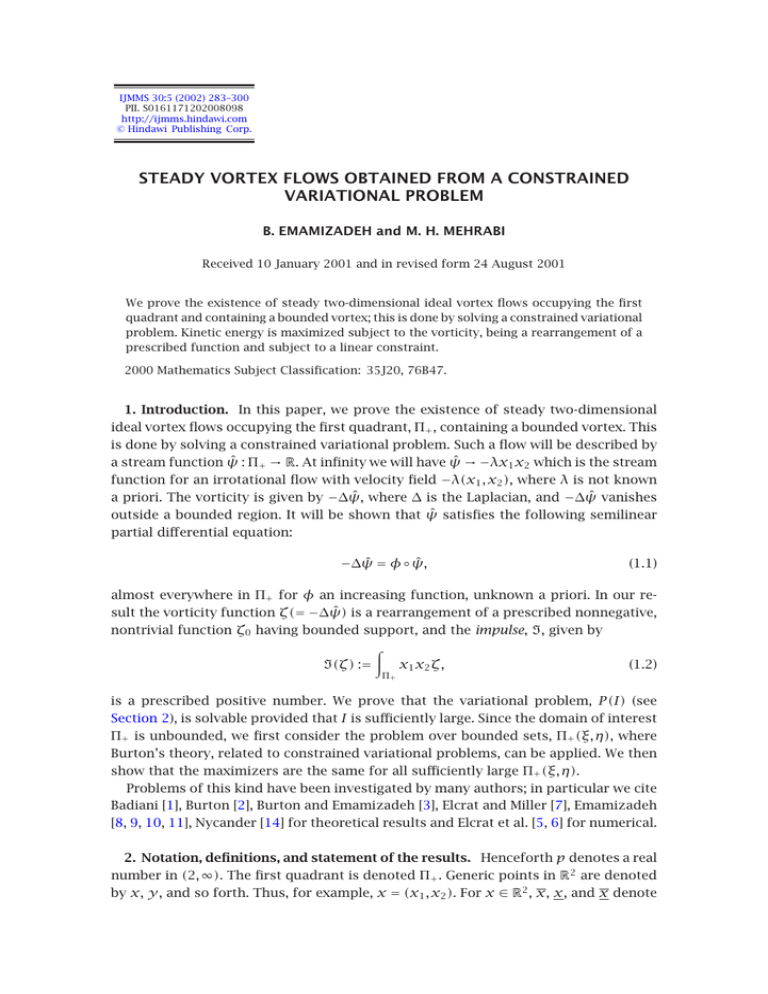
IJMMS 30:5 (2002) 283–300
PII. S0161171202008098
http://ijmms.hindawi.com
© Hindawi Publishing Corp.
STEADY VORTEX FLOWS OBTAINED FROM A CONSTRAINED
VARIATIONAL PROBLEM
B. EMAMIZADEH and M. H. MEHRABI
Received 10 January 2001 and in revised form 24 August 2001
We prove the existence of steady two-dimensional ideal vortex flows occupying the first
quadrant and containing a bounded vortex; this is done by solving a constrained variational
problem. Kinetic energy is maximized subject to the vorticity, being a rearrangement of a
prescribed function and subject to a linear constraint.
2000 Mathematics Subject Classification: 35J20, 76B47.
1. Introduction. In this paper, we prove the existence of steady two-dimensional
ideal vortex flows occupying the first quadrant, Π+ , containing a bounded vortex. This
is done by solving a constrained variational problem. Such a flow will be described by
a stream function ψ̂ : Π+ → R. At infinity we will have ψ̂ → −λx1 x2 which is the stream
function for an irrotational flow with velocity field −λ(x1 , x2 ), where λ is not known
a priori. The vorticity is given by −∆ψ̂, where ∆ is the Laplacian, and −∆ψ̂ vanishes
outside a bounded region. It will be shown that ψ̂ satisfies the following semilinear
partial differential equation:
−∆ψ̂ = φ ◦ ψ̂,
(1.1)
almost everywhere in Π+ for φ an increasing function, unknown a priori. In our result the vorticity function ζ(= −∆ψ̂) is a rearrangement of a prescribed nonnegative,
nontrivial function ζ0 having bounded support, and the impulse, , given by
(ζ) :=
x1 x2 ζ,
(1.2)
Π+
is a prescribed positive number. We prove that the variational problem, P (I) (see
Section 2), is solvable provided that I is sufficiently large. Since the domain of interest
Π+ is unbounded, we first consider the problem over bounded sets, Π+ (ξ, η), where
Burton’s theory, related to constrained variational problems, can be applied. We then
show that the maximizers are the same for all sufficiently large Π+ (ξ, η).
Problems of this kind have been investigated by many authors; in particular we cite
Badiani [1], Burton [2], Burton and Emamizadeh [3], Elcrat and Miller [7], Emamizadeh
[8, 9, 10, 11], Nycander [14] for theoretical results and Elcrat et al. [5, 6] for numerical.
2. Notation, definitions, and statement of the results. Henceforth p denotes a real
number in (2, ∞). The first quadrant is denoted Π+ . Generic points in R2 are denoted
by x, y, and so forth. Thus, for example, x = (x1 , x2 ). For x ∈ R2 , x, x, and x denote
284
B. EMAMIZADEH AND M. H. MEHRABI
the reflections of x about the x1 -axis, x2 -axis, and the origin, respectively. For positive
η and ξ we set
Π+ (η) := x ∈ Π+ | x1 x2 < η ,
(2.1)
Π+ (ξ, η) := x ∈ Π+ | x1 x2 < η, max x1 , x2 < ξ .
For A ⊂ R2 , |A| denotes the two-dimensional Lebesgue measure of A.
For a measurable function ζ, the strong support of ζ is defined by
supp(ζ) = x ∈ dom(ζ) | ζ(x) > 0 .
(2.2)
To define the rearrangement class needed for our variational problem, we fix a nonnegative, nontrivial function ζ0 ∈ Lp (R2 ) which vanishes outside a bounded set. In
addition, we assume that
supp ζ0 = π a2 ,
(2.3)
for some a > 0. We say that ζ is a rearrangement of ζ0 if and only if
x | ζ(x) ≥ α = x | ζ0 (x) ≥ α ,
(2.4)
for every positive α. The set of rearrangements of ζ0 which vanish outside bounded
subsets of Π+ is denoted by Ᏺ. The set of functions ζ ∈ Ᏺ that satisfy (ζ) = I, for
some I > 0, is denoted by Ᏺ(I); and the set of functions in Ᏺ(I) that vanish outside
Π+ (ξ, η) is denoted by Ᏺ(ξ, η, I); to ensure that Ᏺ(ξ, η, I) ≠ ∅, we present the following
definition: let I1 := (ζ0∗ ), where ζ0∗ is the Schwarz-symmetrisation of ζ0 , and assume
that I > I1 ; we say that Π+ (ξ, η) satisfies the hypothesis Ᏼ(I) if the following two
conditions hold:
ξ ≥ η1/2 ,
(2.5)
η ≥ 4 max a2 , l(I) ,
(2.6)
where l(I) := (I −I1 )/
ζ0 1 . Now it is immediate that if Π+ (ξ, η) satisfies Ᏼ(I), for I >
I1 , then Ᏺ(ξ, η, I) ≠ ∅. Indeed if we set t = l(I)1/2 , then (ζ0∗ )t (x) := ζ0∗ (x1 − t, x2 − t)
belongs to Ᏺ(ξ, η, I).
The Green’s function for −∆ on Π+ with homogeneous Dirichlet boundary conditions is denoted by G+ , hence
x − y x − y 1
.
G+ (x, y) =
log
(2.7)
2π
|x − y|x − y Next we define the integral operator K+
K+ ζ(x) =
G+ (x, y)ζ(y)dy,
Π+
(2.8)
for measurable functions ζ on R2 , whenever the integral exists. The Kinetic energy is
defined by
Ψ (ζ) =
ζK+ ζ,
(2.9)
Π+
whenever the integral exists.
STEADY VORTEX FLOWS OBTAINED FROM A CONSTRAINED . . .
285
In this paper, we are concerned with constrained variational problems which are
defined as follows. For I > I1 ,
P (I) : sup Ψ (ζ);
(2.10)
ζ∈Ᏺ(I)
and the corresponding solution set is denoted by Σ(I). If I > I1 and Π+ (ξ, η) satisfies
Ᏼ(I), then we define the truncated variational problem
P (ξ, η, I) :
sup
ζ∈Ᏺ(ξ,η,I)
Ψ (ζ),
(2.11)
with the solution set Σ(ξ, η, I).
We are now in a position to state our main result.
Theorem 2.1. There exists I0 > 0 such that if I > I0 then P (I) has a solution, that is,
Σ(I) ≠ ∅; if ζ is a solution and ψ := K+ ζ then the following semilinear elliptic partial
differential equation holds
−∆ψ = φ ◦ ψ − λx1 x2 ,
a.e. in Π+ ,
(2.12)
where φ is an increasing function and λ > 0, both unknown a priori. Furthermore, I0
can be chosen to ensure that the vortex core, the strong support of ζ, avoids ∂Π+ .
3. Preliminary results. We present some lemmas that are used in the proof of
Theorem 2.1. We begin by stating a lemma from Burton’s theory, see for example,
Burton and McLeod [4].
Lemma 3.1. Let Ω be a nonempty open set in Rn . Let 1 ≤ p < ∞ and p ∗ denote the
conjugate exponent of p. For ζ ∈ Lp (µ) let Ᏺ(Ω) denote the set of rearrangements of ζ
on Ω. Let
ᏸ :=
Ꮽα (x)Ᏸα
(3.1)
1≤|α|≤m
be an mth-order linear partial differential operator, whose coefficients Ꮽα are finitevalued measurable functions on Ω, having no 0th-order term, and suppose that there
∗
exists a compact, symmetric, positive linear operator K : Lp (Ω) → Lp (Ω) such that if
∗
m,1
ζ ∈ Lp (Ω), then Kζ ∈ Lp (Ω)∩Wloc (Ω) and ᏸKζ = ζ almost everywhere in Ω. Define
ˆ :=
Ψ (ζ)
∗
Ω
ζKζ,
ζ ∈ Lp (Ω).
(3.2)
m,1
Let w ∈ Lp (Ω) ∩ Wloc (Ω) be such that ᏸw is essentially constant, and define
᐀(ζ) := wζ, ζ ∈ Lp (Ω).
Ω
(3.3)
Let b ∈ R. Then
(i) If b ∈ ᐀(Ᏺ(Ω)) then
sup Ψ̂ ᐀−1 (b) ∩ Ᏺ(Ω) = sup Ψ̂ ᐀−1 (b) ∩ Ᏺ(Ω)w ,
and the supremum is attained by at least one element of ᐀−1 (b) ∩ Ᏺ(Ω).
(3.4)
286
B. EMAMIZADEH AND M. H. MEHRABI
(ii) If b is, relatively, interior to ᐀(Ᏺ(Ω)), and if ζ is a maximizer for Ψ relative to
᐀−1 (b) ∩ Ᏺ(Ω), then there exist scalar λ and an increasing function φ such that
ζ = φ ◦ Kζ + λw , a.e. in Ω.
(3.5)
Remark 3.2. It is clear that if I > I1 and Π+ (ξ, η) satisfies Ᏼ(I) then, by Lemma
3.1(i), Σ(ξ, η, I) ≠ ∅.
Before stating the next result we give the following definition: for I > I1 ,
σ (I) := inf Ψ (ζ) | ζ ∈ Σ(ξ, η, I), for some Π+ (ξ, η) satisfying Ᏼ(I) .
(3.6)
We point out that σ (I) = Ψ (ζ̂) for some ζ̂ ∈ Σ(ξ0 , η0 , I), where Π+ (ξ0 , η0 ) is the minimal region that satisfies Ᏼ(I).
Lemma 3.3. Let σ be as defined in (3.6), then
lim σ (I) = ∞.
I→∞
(3.7)
Proof. Let I > I1 and set t = l(I)1/2 . If Π+ (ξ, η) satisfies Ᏼ(I), then (ζ0∗ )t ∈ Ᏺ(ξ, η, I)
and therefore, according to the last remark, we have
(3.8)
σ (I) ≥ Ψ ζ0∗ t .
Now applying same method as in Burton [2, Lemma 12], we obtain Ψ ((ζ0∗ )t ) ≥ k log t,
for all sufficiently large t, hence large I. Thus our claim is done.
Let I > I1 and Π+ (ξ, η) satisfies Ᏼ(I). We set
M(ξ, η, I) := (ζ, φ, λ) | ζ ∈ Σ(ξ, η, I) for some φ, λ ∈ R
such that ζ = φ ◦ K+ ζ − λx1 x2 a.e. in Π+ (ξ, η) .
(3.9)
Note that under the conditions imposed on ξ, η, I and in view of Lemma 3.1(ii) the set
M(ξ, η, I) is nonempty. The following two inequalities are standard, see Burton [2]
K+ ζ(x) ≤ N min x1 , x2 ,
(3.10)
∇K+ ζ(x) ≤ N,
(3.11)
for every x ∈ Π+ and every ζ ∈ Ᏺ, where N is a universal constant.
Lemma 3.4. For I > I1 we define
Λ(I) := sup λ | (ζ, φ, λ) ∈ M(ξ, η, I) for some ζ, φ
and some Π+ (ξ, η) satisfying Ᏼ(I) .
(3.12)
Then, lim supI→∞ Λ(I) ≤ 0.
Proof. Assume that the assertion of the lemma is not true and seek a contradiction.
Hence, to this end we suppose that there exists β ∈ (0, ∞] such that lim supI→∞ Λ(I) =
β. Hence there exists Λ > 0 such that the set
S := I | Λ(I) > Λ
(3.13)
is unbounded. Consider I ∈ S, then from the definition of Λ(I), there exists (ζ, φ, λ) ∈
STEADY VORTEX FLOWS OBTAINED FROM A CONSTRAINED . . .
287
M(ξ, η, I) such that Π+ (ξ, η) satisfies Ᏼ(I) and Λ(I) ≥ λ > Λ > 0. Observe that by
taking I sufficiently large we can ensure the existence of ξ1 such that Π+ (ξ, η) ⊇
Π+ (ξ1 , a) and |Π+ (ξ1 , a)| ≥ π a2 = | supp(ζ)|. Now define the set
U := x ∈ Π+ (ξ, η) | K+ ζ(x) − λx1 x2 ≥ −λa .
(3.14)
Then, Π+ (ξ1 , a) ⊆ U and |U | ≥ | supp(ζ)|. Since ζ is essentially an increasing function
of K+ ζ − λx1 x2 on Π+ (ξ, η) we deduce that supp(ζ) ⊆ U .
Next we show that there exists a constant C > 0, independent of I ∈ S, such that
for x ∈ supp(ζ) we have x1 x2 ≤ C. From (3.10) we observe that for a sufficiently large
k>0
K+ ζ(x) ≤
Λ
x1 x 2 ,
2
for all ζ ∈ Ᏺ and all x for which min{x1 , x2 } ≥ k. We next define
S1 : = x ∈ Π+ | min x1 , x2 ≥ k ,
S2 : = x ∈ Π+ | min x1 , x2 < k, x1 < α, x2 < α ,
S3 : = x ∈ Π+ | min x1 , x2 < k, max x1 , x2 ≥ α ,
(3.15)
(3.16)
where α := max{2N/λ, k}. First consider x ∈ supp(ζ) ∩ S1 ; then
−λa ≤ K+ ζ(x) − λx1 x2 ≤
Λ
λ
x1 x2 − λx1 x2 < − x1 x2 ,
2
2
(3.17)
where the first inequality follows from supp(ζ) ⊆ U and the second one from (3.15);
whence x1 x2 < 2a. Next, consider x ∈ supp(ζ) ∩ S2 ; then we have
2
2N
x1 x2 < α2 ≤ max
,k
,
(3.18)
Λ
since λ > Λ. Finally, consider x ∈ supp(ζ) ∩ S3 ; then an application of (3.10) yields
that
−λa ≤ K+ ζ(x) − λx1 x2
≤ N min x1 , x2 − λx1 x2
N
α min x1 , x2 − λx1 x2
α
N
≤ x1 x2 − λx1 x2
α
=
≤N
(3.19)
λ
x1 x2 − λx1 x2
2N
λ
= − x1 x2 ,
2
hence x1 x2 ≤ 2a. Therefore, from above argument, it is clear that a constant C > 0,
as required, exists. This, in turn, implies that
I = (ζ) :=
x1 x2 ζ ≤ C ζ0 1 .
(3.20)
Π+
Thus S is bounded, which is a contradiction. Hence, the proof of Lemma 3.4.
288
B. EMAMIZADEH AND M. H. MEHRABI
Lemma 3.5. For I > I1 we define
A(I) := inf ess inf K+ ζ(x) − λx1 x2 | (ζ, φ, λ) ∈ M(ξ, η, I)
x∈supp(ζ)
for some Π+ (ξ, η) and some φ ,
(3.21)
where Π+ (ξ, η) is to satisfy Ᏼ(I). Then, lim inf I→∞ A(I) ≥ 0.
Proof. Fix > 0. By definition of A(I) there exists Π+ (ξ, η), satisfying Ᏼ(I), and
(ζ, φ, λ) ∈ M(ξ, η, I) such that
A(I) + ≥ ess inf
x∈supp(ζ)
K+ ζ(x) − λx1 x2 .
(3.22)
Note that by increasing I, the size of Π+ (ξ, η) increases as well, hence there is no loss
of generality if we assume that Π+ (ξ, η) contains the square D := [0, 2a] × [0, 2a],
since I will eventually tend to infinity. For x ∈ D we have
K+ ζ(x) − λx1 x2 ≥ −4a2 Λ(I)+ ,
(3.23)
where Λ(I)+ denotes the positive part of Λ(I), since K+ ζ is nonnegative. From this,
we infer that
D ⊆ x ∈ Π+ (ξ, η) | K+ ζ(x) − λx1 x2 ≥ −4a2 Λ(I)+ .
(3.24)
Hence
x ∈ Π+ (ξ, η) | K+ ζ(x) − λx1 x2 ≥ −4a2 Λ(I)+ > supp(ζ),
(3.25)
since 4a2 > | supp(ζ)|. Since ζ is essentially an increasing function of K+ ζ − λx1 x2
on Π+ (ξ, η), we then deduce that
supp(ζ) ⊆ x ∈ Π+ (ξ, η) | K+ ζ(x) − λx1 x2 ≥ −4a2 Λ(I)+ ,
(3.26)
hence, by applying (3.22), we obtain A(I)+ ≥ −4a2 Λ(I)+ . Therefore, from Lemma 3.4
we have
lim inf A(I) + ≥ 0.
I→∞
(3.27)
Since was arbitrary, we derive the desired conclusion.
The next two results can be proved similarly to Burton [2, Lemmas 8 and 9]; they
bear some resemblance to Pohazaev-type identities proved in Friedman and Turkington [12] for 3-dimensional vortex rings. We add that, contrary to Burton [2], we can
give a direct proof, using the weak divergence theorem (see, e.g., Grisvard [13]) for
Lemma 3.6 below without referring to any density theorems.
Lemma 3.6. Let 2 < p < ∞, let ζ ∈ Lp (Π+ ) have bounded support, and let ψ := K+ ζ.
Then
(x · ∇ψ)ζ = 0.
(3.28)
Π+
STEADY VORTEX FLOWS OBTAINED FROM A CONSTRAINED . . .
289
Lemma 3.7. Let 2 < p < ∞, let ζ ∈ Lp (Π+ ) be nonnegative, nontrivial and vanish
outside the square D(ξ) := [0, ξ] × [0, ξ], for some ξ > 0. Let λ ∈ R, and let ψ :=
K+ ζ − λx1 x2 . Suppose that ζ = φ ◦ ψ almost everywhere in D(ξ) for some increasing
function φ, and that φ has a nonnegative indefinite integral F . Then
,
F ◦ ψ − 2λ
x1 x2 ζ =
(F ◦ ψ) x · n
(3.29)
2
D(ξ)
D(ξ)
∂D(ξ)
is the outward unit normal, and consequently
where n
F ◦ψ ≥ λ
x1 x2 ζ.
(3.30)
If additionally F (s) = 0 for some s ≤ β, then
ζK+ ζ ≥ 2λ
(3.31)
D(ξ)
D(ξ)
D(ξ)
D(ξ)
x1 x2 ζ + β
ζ
1 .
Lemma 3.8. For I > I1 we define
µ(I) := inf
sup
K+ ζ(x) − λx1 x2 | (ζ, φ, λ) ∈ M(ξ, η, I)
x∈Π+ (ξ,η)
for some Π+ (ξ, η) satisfying Ᏼ(I), and some φ .
(3.32)
Then limI→∞ µ(I) = ∞.
Proof. It clearly suffices to show that
lim inf µ(I) = ∞.
I→∞
(3.33)
Let I > I1 and consider (ζ, φ, λ) ∈ M(ξ, η, I) for some Π+ (ξ, η) satisfying Ᏼ(I). Since
K+ ζ(x) − λx1 x2 ≥ Λ(I) for almost every x ∈ supp(ζ), we may assume that φ(s) = 0
for −∞ < s < A(I). Now write
s
φ,
(3.34)
F (s) =
−∞
for all s in the domain of φ. Now, by Lemma 3.7, we have
ζ K+ ζ − λx1 x2 = 2Ψ (ζ) − λI
Π+
=
1
1
2Ψ (ζ) − 2λI − A(I)
ζ
1 + Ψ (ζ) + A(I)
ζ
1
2
2
1
≥ Ψ (ζ) + A(I)
ζ
1
2
1
≥ σ (I) + A(I)
ζ
1 .
2
(3.35)
Hence
σ (I) 1
+ A(I).
K+ ζ(x) − λx1 x2 ≥
ζ
1 2
Π+ (ξ,η)
sup
(3.36)
290
B. EMAMIZADEH AND M. H. MEHRABI
Therefore
µ(I) ≥
σ (I) 1
+ A(I).
ζ
1 2
(3.37)
Thus by applying Lemmas 3.4 and 3.5 we obtain (3.33).
Lemma 3.9. There exists I2 > I1 such that
A(I) ≥ aN,
I ≥ I2 .
(3.38)
Proof. By Lemma 3.7 there exists I2 > I1 such that
µ(I) ≥ 7aN,
I ≥ I2 ;
(3.39)
moreover by taking I2 sufficiently large we can ensure that if I ≥ I2 , then any Π+ (ξ, η)
satisfying Ᏼ(I), also satisfies
Π+ (ξ, η) \ Π+ ξ, η ≥ π a2 .
2 (3.40)
To see it, observe that in general we have
2
Π+ (ξ, η) = η 1 + log ξ ,
η
(3.41)
for any Π+ (ξ, η) satisfying (2.5); therefore
Π+ (ξ, η) \ Π+ ξ, η ≥ 1 (1 − log 2)η.
2 2
(3.42)
Hence, in view of (2.6), for sufficiently large I we derive (3.40). Now, fix I ≥ I2 and
consider (ζ, φ, λ) ∈ M(ξ, η, I) for some Π+ (ξ, η) satisfying Ᏼ(I). Since K+ ζ −λx1 x2 ∈
C(Π+ (ξ, η)), it attains its maximum at, say, z ∈ Π+ (ξ, η). Now from the definition of
µ(I) and (3.10) we infer that
µ(I) ≤ K+ ζ(z) − λz1 z2 ≤ N min z1 , z2 − λz1 z2 ;
(3.43)
and applying (3.39), we obtain
7aN ≤ N min z1 , z2 − λz1 z2 .
(3.44)
Clearly, if λ ≥ 0 we obtain min{z1 , z2 } ≥ 7a. If λ < 0, then
7aN ≤ N min z1 , z2 − λη,
(3.45)
N min z1 , z2 ≥ 7aN + λη.
(3.46)
or
Now we consider two cases.
STEADY VORTEX FLOWS OBTAINED FROM A CONSTRAINED . . .
291
Case 1. When λη ≥ −2aN, then N min{z1 , z2 } ≥ 5aN, hence min{z1 , z2 } ≥ 5a.
Therefore, when λ ≥ 0, or when λ < 0, and λη ≥ −2aN we find that min{z1 , z2 } ≥ 5a.
Thus Π+ (ξ, η) must contain at least a quadrant of B4a (z), denoted by Q. For x ∈ Q,
by the mean value inequality, we have
K+ ζ(x) − λx1 x2 ≥ K+ ζ(x)
≥ K+ ζ(z) − 4aN
= K+ ζ(z) − λz1 z2 − 4aN + λz1 z2
≥ µ(I) − 4aN + λz1 z2
(3.47)
≥ µ(I) − 4aN + λη
≥ 7aN − 4aN − 2aN
= aN.
This means that
Q ⊆ x ∈ Π+ (ξ, η) | K+ ζ(x) − λx1 x2 ≥ aN .
(3.48)
Case 2. When λη < −2aN, then for x ∈ Π+ (ξ, η) \ Π+ (ξ, η/2) we have
λη
K+ ζ(x) − λx1 x2 ≥ −λx1 x2 > −
;
2
η
⊂ x ∈ Π+ (ξ, η) | K+ ζ(x) − λx1 x2 ≥ aN .
Π+ (ξ, η) \ Π+ ξ,
2
(3.49)
From (3.40) and the fact that |Q| = 4π a2 , we infer that
x ∈ Π+ (ξ, η) | K+ ζ(x) − λx1 x2 ≥ aN ≥ supp(ζ).
(3.50)
Since ζ is an increasing function of K+ ζ − λx1 x2 on Π+ (ξ, η), we derive
supp(ζ) ⊆ x ∈ Π+ (ξ, η) | K+ ζ(x) − λx1 x2 ≥ aN ,
(3.51)
modulo a set of zero measure, from which we obtain (3.38).
Lemma 3.10. Let b > 0, let 2 < p < ∞ and 0 < γ < 1. Then there exist positive
constants M1 , M2 , and M3 such that
−1
−1
25x1 x2
(ζ) + M2 x1 x2
(ζ) log
K+ ζ(x) ≤ M1 x1 x2
4|x|
−γ
1−γ
+ M3 x 1 x 2
(ζ)γ ζ
p ,
(3.52)
for every x ∈ Π+ such that min{x1 x2 } ≥ b/2 and every nonnegative ζ ∈ Lp (Π+ ) that
vanishes outside a set of measure π b2 .
Proof. Fix x ∈ Π+ such that ν := min{x1 x2 } ≥ b/2. For y ∈ Π+ we define
α := x − y ,
β := x − y ,
ρ := |x − y|,
δ := x − y .
(3.53)
292
B. EMAMIZADEH AND M. H. MEHRABI
Thus
K+ ζ(x) =
=
1
2π
1
2π
+
Π+
αβ
ζ(y)dy
ρδ
log
log
Bν/2 (x)
1
2π
αβ
ζ(y)dy
ρδ
Π+ \Bν/2 (x)
log
(3.54)
αβ
ζ(y)dy,
ρδ
where Bν/2 (x) denotes the ball centered at x with radius ν. From the identity
α2 β2 = ρ 2 δ2 + 16x1 x2 y1 y2 ,
(3.55)
we obtain
Π+ \Bν/2 (x)
log
16x1 x2 y1 y2
log 1 +
ζ(y)dy
ρ 2 δ2
Π+ \Bν/2 (x)
y1 y2
ζ(y)dy
≤ 8x1 x2
2 2
Π+ \Bν/2 (x) ρ δ
32x1 x2
≤ 2
y1 y2 ζ(y)dy
ν |x|2 Π+ \Bν/2 (x)
αβ
1
ζ(y)dy =
ρδ
2
(3.56)
−1
(ζ),
≤ 32 x1 x2
where the first inequality follows from the fact that log(1 + x) ≤ x, for x ≥ 0. To
estimate Bν/2 (x) log(αβρ −1 δ−1 )ζ(y)dy, we note that for y ∈ Bν/2 (x) we have
5
α ≤ x − x + x − y = 2x2 + ρ < x2 .
2
(3.57)
Similarly, β < 5/2x1 . Therefore
log
Bν/2 (x)
25x1 x2
ζ(y)dy
4ρ|x|
25x1 x2
ζ(y)dy
= log
4|x|
Bν/2 (x)
1
log ζ(y)dy.
+
ρ
Bν/2 (x)
αβ
ζ(y)dy ≤
ρδ
log
Bν/2 (x)
(3.58)
Observe that for y ∈ Bν/2 (x) we have y1 y2 ≥ x1 x2 /4, hence
Bν/2 (x)
−1
ζ(y)dy ≤ 4 x1 x2
Bν/2 (x)
−1
y1 y2 ζ(y)dy ≤ 4 x1 x2
(ζ).
(3.59)
293
STEADY VORTEX FLOWS OBTAINED FROM A CONSTRAINED . . .
On the other hand, if we let ζ̂ denote the Schwarz-symmetrisation of ζ := ζχBν/2 (x) ,
where χBν/2 (x) is the characteristic function of Bν/2 (x) in Π+ , about x; then by a standard inequality (see, e.g., [3]) and Hölder’s inequality we obtain
1
1
log ζ(y)dy ≤
log ζ̂(y)dy
ρ
ρ
Bν/2 (x)
Bν/2 (x)
(3.60)
τ
1/τ
1
≤
ζ̂ ,
log ρ dy
Bb̂ (x)
where b̂ := | supp(ζχBν/2 (x) )| (≤ b), := p/(1 + pγ − γ) and τ is the conjugate exponent of . It is elementary to show that
Bb̂ (x)
τ
log 1 dy ≤ C,
ρ
(3.61)
where C is a constant independent of x. Next observe that = γ + (1 − γ)p and
γ < 1, hence applying the standard interpolation inequality yields
γ (1−γ)p
ζ̂ ≤ ζ̂ ζ̂ ,
(3.62)
ζ̂ ≤ ζ̂ γ ζ̂ (1−γ)p/ = ζ̂ γ ζ̂ 1−γ .
1
p
1
p
(3.63)
ζ̂ ≤ 4γ x1 x2 −γ (ζ)γ ζ
1−γ
p .
(3.64)
1
p
or
Therefore, we obtain
Finally from (3.56), (3.58), (3.60), (3.61), and (3.64) we derive (3.52).
By a simple modification of Burton [2, Lemma 1] we get the following lemma.
Lemma 3.11. Let ζ be a nonnegative measurable function on Π+ , let t > 0. Let ζt
be the function, defined on Π+ , obtained by translating ζ along the diagonal of Π+ ,
√
diag(Π+ ), 2t units, that is,
ζ x1 − t, x2 − t , x1 ≥ t, x2 ≥ t
ζt x1 , x2 :=
0,
0 < x1 < t, 0 < x2 < t.
(3.65)
Then
Π+
ζt K+ ζt ≥
Π+
ζK+ ζ.
(3.66)
Lemma 3.12. Let 2 < p < ∞ and ζ ∈ Lp (Π+ ) be a nonnegative, nontrivial function
which vanishes outside Π+ (h) for some h > 0. Then
K+ ζ(x) ≤
4hx x
1 2 ζ
1 + N min x1 , x2 ,
π x12 − x22 provided that x ∈ Π+ \ diag(Π+).
(3.67)
294
B. EMAMIZADEH AND M. H. MEHRABI
Proof. Fix x ∈ Π+ \ diag(Π+ ) and define
1/2 .
U (x) := y ∈ Π+ y12 − y22 − x12 − x22 < x12 − x22 (3.68)
Next we decompose ζ as follows: ζ := ζ1 + ζ2 , where
ζ(y), y ∈ Π+ (h) ∩ U(x),
ζ1 (y) :=
0,
otherwise.
(3.69)
Again by setting α := |x − y|, β := |x − y|, ρ := |x − y|, δ := |x − y|, we obtain
α2 β2
ζ2 (y)dy
ρ 2 δ2
Π+
16x1 x2 y1 y2
1
log 1 +
ζ2 (y)dy
=
4π Π+
ρ 2 δ2
1
4hx1 x2
ζ (y)dy.
≤
2 2 2
π
Π+ \U (x) ρ δ
K+ ζ2 (x) =
1
4π
log
(3.70)
In view of the following identity:
ρ 2 δ2 =
2
2
2
y1 − y22 − x12 − x22
+ 4 x 1 x 2 − y1 y 2 ,
(3.71)
we infer that if y ∈ Π+ \ U (x), then ρ 2 δ2 > |x12 − x22 |. This, in conjunction with (3.70),
yields
K+ ζ2 (x) ≤
4hx x
1 2 ζ
1 .
π x12 − x22 (3.72)
Finally, recalling (2.5) we obtain
K+ ζ1 (x) ≤ N min x1 , x2 .
(3.73)
Since K+ ζ(x) = K+ ζ1 (x) + K+ ζ2 (x), (3.67) follows from (3.72) and (3.73).
Remark 3.13. Under the hypotheses of Lemma 3.12 with b replaced by a and an
additional assumption, namely, (ζ) ≥ 1 we can show the existence of a positive
constant P such that
−γ
(ζ),
K+ ζ(x) ≤ P x1 x2
(3.74)
provided that min{x1 , x2 } ≥ a/2 and ζ ∈ Ᏺ. Clearly, the truth of (3.74) emerges from
the elementary fact that s γ−1 log s is bounded on any interval of the form [d, ∞), d > 0.
STEADY VORTEX FLOWS OBTAINED FROM A CONSTRAINED . . .
295
4. Proof of Theorem 2.1. We first show that, for I sufficiently large, there exists a
positive constant R(I) such that if Π+ (ξ, η) is sufficiently large (satisfying Ᏼ(I)) and
ζ ∈ Σ(ξ, η, I), then
supp(ζ) ⊂ Π+ R(I) ,
(4.1)
modulo a set of zero measure. From Lemma 3.3, there exists I3 > I1 such that if I > I3 ,
then
σ (I) >
5
aN ζ0 1 .
2
(4.2)
Fix I > I3 and consider ζ ∈ Σ(ξ, η, I) for some Π+ (ξ, η) satisfying Ᏼ(I). From (4.2) and
definition of σ , we infer that
5
1
aN
ζ
1 ≤ Ψ (ζ) ≤ ζ
1 sup K+ ζ(x),
2
2
x∈supp(ζ)
(4.3)
thus
sup
x∈supp(ζ)
K+ ζ(x) ≥ 5aN.
(4.4)
Since K+ ζ ∈ C(R2 ), it attains its maximum relative to supp(ζ) at z, say. Therefore, by
applying (4.4), we obtain
5aN ≤ K+ ζ(z) ≤ N min z1 , z2 ,
(4.5)
whence min{z1 , z2 } ≥ 5a. Without loss of generality, we may assume that (ζ) ≥ 1,
hence, by (3.74) we obtain
−γ
,
5aN ≤ K+ ζ(z) ≤ P I z1 z2
(4.6)
so
z1 z2 ≤
PI
5aN
γ
.
(4.7)
, 25a2 .
(4.8)
Now we define
R(I) := max
PI
5aN
γ
Then V := {x ∈ Π+ | x1 x2 ≤ R(I), min{x1 , x2 } ≥ 5a} is not empty and z ∈ V . Note that
at least a quadrant of B4a (x), for every x ∈ V , is contained in Π+ (R(I)) and, in fact,
t
(ξ1 , R(I)) we denote the translacontained in Π+ (ξ1 , R(I)) for some ξ12 > R(I). By Π+
√
tion of Π+ (ξ1 , R(I)) along diag(Π+ ), 2t units. Observe that the family of translations
t
{Π+
(ξ1 , R(I))}0≤t≤t0 , where t0 := (I/
ζ0 1 )1/2 , is uniformly contained in Π+ (ξ2 , η2 ),
for some ξ2 and η2 (in fact we can take ξ2 = ξ1 +t0 ). From now on we assume that ξ > ξ2
and η > η2 . Since a quadrant of B4a (z), designated by Q, is contained in Π+ (R(I)) we
can apply the mean value inequality and (2.5) to deduce that
K+ ζ(x) ≥ K+ ζ(z) − 4aN ≥ aN,
x ∈ Q,
(4.9)
296
B. EMAMIZADEH AND M. H. MEHRABI
where the last inequality is obtained from (4.4). To seek a contradiction we assume
that E := supp(ζ) \ Π+ (R(I)) has a positive measure and write ζ = ζ0 + ζ1 , where
ζ1 := ζχE .
(4.10)
Since |Q| = 4π a2 > | supp(ζ)| = π a2 , there exists a measure preserving bijection,
denoted by T , from E onto a subset of Q \ supp(ζ), say G, see Royden [15]. Now
define
(4.11)
ζ2 := ζ1 ◦ T −1 ,
on the range of T and zero elsewhere, that is,
ζ2 = ζ1 ◦ T −1 χim(T ) ,
(4.12)
where im(T ) is the range of T , and let ζ := ζ0 +ζ2 . Clearly ζ ∈ Ᏺ(ξ, η). We show that
(ζ ) < (ζ):
ζ =
x1 x2 ζ 0 +
x1 x2 ζ 2
=
=
<
Π+
Π+
Π+
Π+
x1 x2 ζ 0 +
x1 x2 ζ 0 +
x1 x2 ζ 0 +
Π+
Π+
E
x1 x2 ζ1 ◦ T −1
x1 x2 ◦ T ζ 1
Π+
(4.13)
x1 x2 ζ 1
= (ζ).
On the other hand, we have
ζ2 − ζ1 K+ ζ + Ψ ζ2 − ζ1 >
Ψ ζ − Ψ (ζ) =
Π+
Π+
ζ2 − ζ1 K+ ζ,
since K+ is strictly positive, see Emamizadeh [10]. Hence
Ψ ζ − Ψ (ζ) >
ζ2 K+ ζ −
Π+
≥ aN
by (4.9). Now we proceed to estimate
Π+
ζ2 −
{x∈Π+ |x1 x2 >R(I)}
{x∈Π+ |x1 x2 >R(I)}
{x∈Π+ |x1 x2 >R(I)} ζ1 K+ ζ.
(4.14)
ζ1 K+ ζ
(4.15)
ζ1 K+ ζ,
For this purpose we set
supp(ζ) = J1 ∪ J2 ,
(4.16)
a
J1 : = x ∈ supp(ζ) | x1 x2 > R(I), min x1 , x2 ≥
,
2
a
.
J2 : = x ∈ supp(ζ) | x1 x2 > R(I), min x1 , x2 <
2
(4.17)
where
STEADY VORTEX FLOWS OBTAINED FROM A CONSTRAINED . . .
297
If x ∈ J1 , then by (3.74)
−γ
K+ ζ(x) ≤ P I x1 x2
≤ P IR(I)−γ .
(4.18)
On the other hand, if x ∈ J2 then by (2.5)
a
K+ ζ(x) ≤ N min x1 , x2 ≤ .
2
(4.19)
aN
.
K+ ζ(x) ≤ max P IR(I)−γ ,
2
(4.20)
Therefore, if x ∈ supp(ζ1 )
Assume that R(I) is large enough to ensure
aN
aN − max P IR(I)−γ ,
> 0.
2
(4.21)
Therefore, we obtain
aN
ζ1 > 0.
Ψ ζ − Ψ (ζ) ≥ aN − max P IR(I)−γ ,
1
2
(4.22)
This implies that Ψ (ζ ) > Ψ (ζ). Finally, we define ζ to be the function obtained by
translating ζ along diag(Π+ ) so that (ζ ) = I. If we denote the amount of translation
by t, then it is clear that t is the bigger root of the following algebraic equation:
2
ζ t + 2
x1 x2 ζ = I.
(4.23)
x 1 + x2 ζ t +
1
Π+
Π+
Note that t depends on ζ; but we are able to find a uniform bound, independent of ζ,
as follows. Solving (4.23) for t yields
−
t=
Π+
x 1 + x2 ζ +
x 1 + x2 ζ Π+
ζ 1
1/2
< ζ 1 I − ζ <
I
ζ 1
2
1/2
− ζ 1 ζ − I
1/2
(4.24)
,
as desired. Note that the choices of ξ2 and η2 ensure that ζ ∈ Ᏺ(ξ, η, I). Now, by
Lemma 3.11 we have
Ψ ζ ≥ Ψ ζ > Ψ (ζ).
(4.25)
This is a contradiction to the maximality of ζ. Therefore we have been able to show
that if I > I3 , then there exists R(I) given by (4.8) such that if Π+ (ξ, η) is sufficiently
large (ξ ≥ ξ2 and η ≥ η2 ) and ζ ∈ Σ(ξ, η, I), then, for almost every x ∈ supp(ζ), (4.1)
holds.
However, the possibility that the vortex core runs off to infinity, as Π+ (ξ, η) exhausts
Π+ , still exists. We now show that this situation is ruled out once I is sufficiently large.
For this purpose, fix I > I3 and consider (ζ, φ, λ) ∈ M(ξ, η, I). We claim that if ξ and
298
B. EMAMIZADEH AND M. H. MEHRABI
η are large enough then λ can not be too negative. For this purpose let ξ ≥ ξ2 and
η ≥ max{h, η2 }, ξ2 and η2 are as above, where
−1
h := N λ∗ + 1 R(I),
λ∗ := −
aN
,
3R(I)
(4.26)
such that Π+ (ξ, η) satisfies Ᏼ(I). We show that
λ > λ∗ .
(4.27)
To seek a contradiction suppose that λ ≤ λ∗ . Without loss of generality we may assume
that R(I) ≥ 1. Let x ∈ W := {y ∈ Π+ (ξ, η) | y1 y2 > h}. Then
K+ ζ(x) − λx1 x2 > −λx1 x2 = |λ|x1 x2 > |λ|h
−1
= |λ| N λ∗ + 1 R(I) > N + |λ| R(I).
(4.28)
Now consider x ∈ supp(ζ). If max{x1 , x2 } ≥ 1, then min{x1 , x2 } ≤ x1 x2 , hence
min{x1 , x2 } ≤ R(I). If, however, max{x1 , x2 } < 1 then min{x1 , x2 } < 1 ≤ R(I). Therefore in either case we have min{x1 , x2 } ≤ R(I). This, in turn, implies that
K+ ζ(x) − λx1 x2 ≤ N min x1 , x2 − λx1 x2 < N + |λ| R(I),
(4.29)
whence
sup
x∈supp(ζ)
K+ ζ(x) − λx1 x2 ≤ N + |λ| R(I).
(4.30)
Therefore K+ ζ(x) − λx1 x2 takes greater values on a nonempty subset of Π+ (ξ, η),
namely W , than its supremum on supp(ζ). This is impossible, since ζ is essentially
an increasing function of K+ ζ(x)−λx1 x2 on Π+ (ξ, η). Hence we derive (4.27). For the
rest of the proof we fix I > I0 := max{I1 , I2 , I3 }. Let ξ > ξ2 , η > h (as above) be such that
Π+ (ξ, η) satisfies Ᏼ(I). Consider (ζ, φ, λ) ∈ M(ξ, η, I). Now fix x ∈ supp(ζ)\diag(Π+ )
such that min{x1 , x2 } < a/6. Then by Lemmas 3.9 and 3.12, in conjunction with (4.27),
aN ≤ K+ ζ(x) − λx1 x2
Hence
≤
4R(I)x1 x2
∗
2
2 ζ
1 + N min x1 , x2 − λ x1 x2
π x1 − x2
≤
4R(I)x1 x2
ζ
1 + N min x1 , x2 − λ∗ R(I)
π x12 − x22 ≤
aN aN
4R(I)x1 x2
ζ
1 +
+
.
6
3
π x12 − x22 2
x − x 2 < 8R(I) ζ0 1 .
1
2
aπ N
(4.31)
(4.32)
To summarise, we have shown that if x ∈ supp(ζ) is such that min{x1 , x2 } > a/6,
then x ∈ Π+ (R(I)) ∩ {y ∈ Π+ | min{y1 , y2 } > a/6}; otherwise x satisfies (4.32). This
clearly concludes the existence part of the theorem.
STEADY VORTEX FLOWS OBTAINED FROM A CONSTRAINED . . .
299
Now consider ζ ∈ Σ(I). Then there exists ξ̂ > 0 such that supp(ζ) is a compact
subset of D(ξ̂) := (0, ξ̂) × (0, ξ̂) and, according to Lemma 3.1,
ζ = φ ◦ K+ ζ − λx1 x2 ,
a.e. in D ξ̂ ,
(4.33)
for some increasing function φ and λ ∈ R. Note that from Lemma 3.9
κ := ess sup K+ ζ(x) − λx1 x2 | x ∈ supp(ζ) ≥ aN > 0.
(4.34)
Since the level sets of K+ ζ − λx1 x2 , on supp(ζ), have zero measure, in particular we
have
x ∈ supp(ζ) | K+ ζ − λx1 x2 = κ = 0.
(4.35)
Therefore
K+ ζ − λx1 x2 > κ,
a.e. in supp(ζ).
Thus we may suppose that φ(s) = 0 for s ≤ κ. Now if we define F (s) :=
Lemma 3.7 yields
,
2
F ◦ ψ − 2λI =
(F ◦ ψ) x · n
D(ξ̂)
(4.36)
s
0
φ(t)dt, then
(4.37)
∂D(ξ̂)
where ψ := K+ ζ − λx1 x2 . We claim that for x ∈ ∂D(ξ̂) we have ψ ≤ κ. Otherwise, by
the continuity of ψ we can find B (x) such that B (x)∩supp(ζ) has positive measure,
since supp(ζ) is a compact subset of D(ξ̂), and ψ(s) > κ for s ∈ B (x); but this is a
contradiction to (4.33). Therefore, if x ∈ ∂D(ξ̂) we have F ◦ψ(x) = 0. Hence from (4.37)
we deduce that λ > 0, as required.
Now fix x ∈ supp(ζ). Since λ > 0, we can employ Lemma 3.9 to obtain
aN ≤ K+ ζ(x) − λx1 x2 < K+ ζ(x) ≤ N min x1 , x2 .
(4.38)
Thus min{x1 , x2 } ≥ a. This proves the vortex core avoids ∂Π+ . The validity of (2.12)
is established as in Emamizadeh [11].
References
[1]
[2]
[3]
[4]
[5]
[6]
T. V. Badiani, Existence of steady symmetric vortex pairs on a planar domain with an
obstacle, Math. Proc. Cambridge Philos. Soc. 123 (1998), no. 2, 365–384.
G. R. Burton, Steady symmetric vortex pairs and rearrangements, Proc. Roy. Soc. Edinburgh Sect. A 108 (1988), no. 3-4, 269–290.
G. R. Burton and B. Emamizadeh, A constrained variational problem for steady vortices in
a shear flow, Comm. Partial Differential Equations 24 (1999), no. 7-8, 1341–1365.
G. R. Burton and J. B. McLeod, Maximisation and minimisation on classes of rearrangements, Proc. Roy. Soc. Edinburgh Sect. A 119 (1991), no. 3-4, 287–300.
A. R. Elcrat, B. Fornberg, M. Horn, and K. Miller, Some steady vortex flows past a circular
cylinder, J. Fluid Mech. 409 (2000), 13–27.
A. R. Elcrat, B. Fornberg, and K. Miller, Steady vortex flows obtained from a nonlinear
eigenvalue problem, Flows and Related Numerical Methods (Toulouse, 1998), Soc.
Math. Appl. Indust., Paris, 1999, pp. 130–136.
300
[7]
[8]
[9]
[10]
[11]
[12]
[13]
[14]
[15]
B. EMAMIZADEH AND M. H. MEHRABI
A. R. Elcrat and K. G. Miller, Rearrangements in steady multiple vortex flows, Comm.
Partial Differential Equations 20 (1995), no. 9-10, 1481–1490.
B. Emamizadeh, The complete proof of Nycander’s problem, The 2nd International Conference on Applied Mathematics (Tehran, October 25–27, 2000), Iran University of
Science and Technology (IUST), 2000, pp. 44–56.
, Rearrangements of functions and 2D ideal fluids, The 2nd International Conference on Applied Mathematics (Tehran, October 25–27, 2000), Iran University of
Science and Technology (IUST), 2000, pp. 46–54.
, Steady vortex in a uniform shear flow of an ideal fluid, Proc. Roy. Soc. Edinburgh
Sect. A 130 (2000), no. 4, 801–812.
, Existence of a steady flow with a bounded vortex in an unbounded domain, J. Sci.
Islam. Repub. Iran 12 (2001), no. 1, 57–63.
A. Friedman and B. Turkington, Vortex rings: existence and asymptotic estimates, Trans.
Amer. Math. Soc. 268 (1981), no. 1, 1–37.
P. Grisvard, Singularities in Boundary Value Problems, Recherches en Mathématiques Appliquées, vol. 22, Masson, Paris, 1992.
J. Nycander, Existence and stability of stationary vortices in a uniform shear flow, J. Fluid
Mech. 287 (1995), 119–132.
H. L. Royden, Real Analysis, The Macmillan, New York, 1963.
B. Emamizadeh: Department of Mathematics, Iran University of Science and
Technology, Narmak 16844, Tehran, Iran
Current address: Institute for Studies in Theoretical Physics and Mathematics,
Niavaran Building, Niavaran Square, Tehran, Iran
M. H. Mehrabi: Department of Mathematics, Iran University of Science and Technology, Narmak 16844, Tehran, Iran


